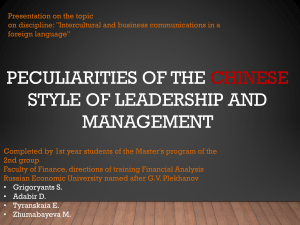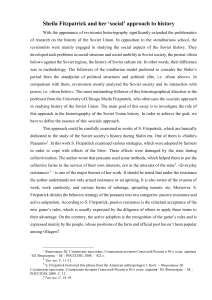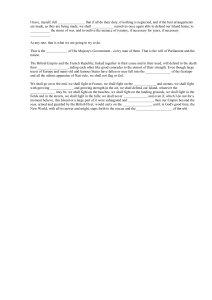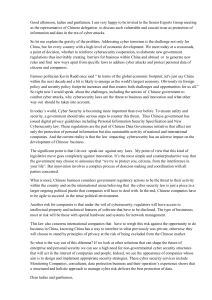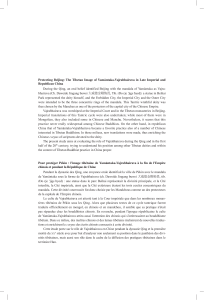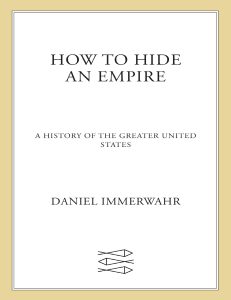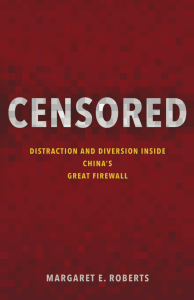Image of Empire and Asia in the Contemporary Science Fictions of
реклама
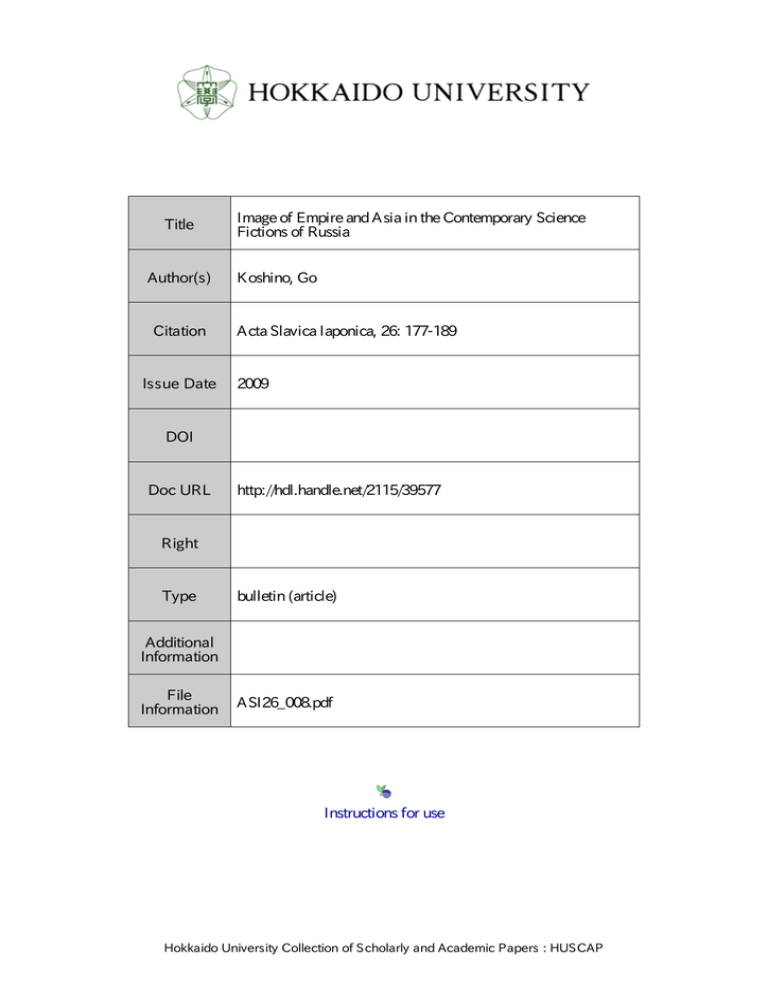
Title Author(s) Citation Issue Date Image of Empire and Asia in the Contemporary Science Fictions of Russia Koshino, Go Acta Slavica Iaponica, 26: 177-189 2009 DOI Doc URL http://hdl.handle.net/2115/39577 Right Type bulletin (article) Additional Information File Information ASI26_008.pdf Instructions for use Hokkaido University Collection of Scholarly and Academic Papers : HUSCAP Acta Slavica Iaponica, Tomus 26, pp. 177‒189 Image of Empire and Asia in the Contemporary Science Fictions of Russia KOSHINO Go Science fiction, as a genre of popular culture, chooses its locale from unlimited time and space and, therefore, is susceptible to the general mentality and spatial/temporal perception of the era. Desirable “topos” in works of fiction can be different in various times and, therefore, Russian SF also has undergone great changes in the setting of the story from the nineteenth to the twenty-first century. Soviet SF writers described ideal communist utopias in the future and often set their stories in international contexts. One can find an example of this type of future society in Ivan Efremov’s The Andromeda Nebula (1957). By contrast, their post-Soviet counterparts tend to imagine “alternative” (counterfactual) Russian history in the past. Recent Russian literature and cinema, especially in the genre of science fiction, expresses nostalgia for the Lost Empires (be it Romanov or Soviet). A critic of Russian SF, Evgenii Kharitonov, argues with some irony that many younger writers, disciples of the brothers Strugatskii, often blocked from publishing their works under the Soviet regime, suddenly became champions of a strong empire in the 1990s.1 � ��������������� Moreover, they often associate these fictive histories of Russia with Eastern or Asian empires, such as Mongolia and China, which will be the main theme in this paper. To explore this peculiar situation of post-Soviet literature, the first section of this paper is dedicated to Vladimir Odoevskii’s The Year 4338 (1839, 1926), which expressed visions of the future world, divided between the Russian and Chinese empires, especially analyzing how this Asian image in the novel was interpreted in various periods after it had been written. In subsequent sections I focus on vigorous arguments in the late- and post-Soviet historical sciences, which have a huge impact on contemporary SF writers, that is, about desirable “historical alternative” as well as Lev Gumilev’s neo-Eurasianist idea. The final part of the paper is devoted to analysis of the texts of “alternative history,” a sub-genre of contemporary science fiction. I choose two examples: A Bite of Angel (2000) by Pavel Krusanov and Eurasian Symphony (2000– ) by Kholm van Zaichik. Both works speculate on a fictional historical world, dominated by the Russian and Chinese empires. 1 Харитонов Е. «Русское поле» утопии (Россия в зеркале утопии). 2001 [����� http�://fandom�. rusf��� .�� ru/about���� _��� fan/haritonov����������������������������������������������������������� _06.������������������������������������������������������� htm���������������������������������������������������� ]. About�������������������������������������������� ������������������������������������������������� the���������������������������������������� ������������������������������������������� boom����������������������������������� ��������������������������������������� of�������������������������������� ���������������������������������� the���������������������������� ������������������������������� imperial������������������� ��������������������������� theme������������� ������������������ and��������� ������������ the����� �������� sub���� genre������������������������������������������������������������ “���������������������������������������������������������� alternative����������������������������������������������� history��������������������������������������� ���������������������������������������������� ” in����������������������������������� ������������������������������������� Russian��������������������������� ���������������������������������� Science������������������� �������������������������� Fiction����������� ������������������ see������� ���������� also�� ������: Петухова Е.И., Черный И.В. Современный русский историко-фантатический роман. М., 2003 [����� http�://fandom������ .����� rusf�. ru/about���� _��� fan/cherny���������� _17.������ htm��� ]; Виттенберг В.М. Игры корректировщиков (Заметки на полях «альтернативных историй») // Новое Литературное Обозрение. 2004. № 66. 177 Acta Slavica Iaponica Odoevskii’s Future Utopia and the Russian View on China Vladimir Odoevskii (1803–1869) was a famous prose writer during the Romantic period. His novel The Year 4338, written in the late 1830s, is one of the first future utopias in the history of Russian literature.2 ������������������� The ������������������ novel’s hero, Chinese student Ippolit Tsungiev, visits the capital city of the Russian Empire in the forty-fourth century. By this time Moscow and Petersburg have been absorbed into one megalopolis. Since the main form of public transportation is electric airship (�������������������������������������������������������������� гальваностат�������������������������������������������������� ), many buildings in the city display the owner’s names on the roof. A huge pipeline network has been constructed, carrying warm air from the equator to the north, and the railroad (�������������������� электроход���������� ) tunnels go through the Himalayas and under the Caspian Sea. Art and science are carefully cultivated by the state, since the emperor is also the first poet in the Russian Empire. Russia in the far future is the most culturally advanced and territorially expanded country, the capital city called the “center of the Russian hemisphere and world enlightenment (������������������������������������������ центр русского полушария и всемирного просвещения��������������������������������������������������������������������� ).” ����������������������������������������������������������������� China ���������������������������������������������������������������� also remains a great empire, rapidly developing under the far-reaching influence of Russian high civilization. Americans have degenerated into troublesome barbarians, robbing neighboring countries, while European powers have already perished without a trace. Archeologists even argue about the meaning of the ancient word “German (���������������� немец����������� )” in vain. Odoevskii took a middle viewpoint in the animated debate of the 1840s between Slavophiles (����������������� Славянофилы������ ) and ���������������������������������� Westernizers (�������������������� Западники����������� ). In his masterpiece Russian Nights (1844), curiously composed of novels and essays, he criticized egoistic utilitarianism in western civilization, but, on the other hand, viewed Russia’s glorious future through the development of science and technology, that is, the way paved by the westernizing reforms of Peter the Great. The last passage in Russian Nights predicts that “the Twenty Century will be ours (russkii/��������������������������������������������������������� Russian)!” ���������������������������������������������� Chinese ��������������������������������������������� student Tsungiev in the forty-fourth century also meditates about a similar historical dilemma that his homeland has faced. (...) что было бы с нами, если б за 500 лет перед сим не родился наш великий Хун-Гин, который пробудил наконец Китай от его векового усыпления или, лучше сказать, мертвого застоя (...) Ужас подумать, что не более двухсот лет, как воздухоплавание у нас вошло во всеобщее употребление, и что лишь победы русских над нами научили нас сему искусству. А 2 Сакулин П.Н. Из истории русского идеализма. Князь В.Ф. Одоевский. Мыслитель – писатель. Т. 1. Ч. 2. М., 1913. С. 178–202; Alexander���������������������������������� ������������������������������������������� Levitsky������������������������� ��������������������������������� , “���������������������� V��������������������� . F������������������ ������������������� . Odoevskij������� ���������������� ’������ s����� The� ���� Year������������������������������������ 4���������������������������������� 338: Eutopia or Dystopia?” i������ ������� n Amy ��������������������������������� Mandelker, Roberta Reeder�������� , eds.�� ������,� The Supernatural in Slavic and Baltic Literature: Essays in Honor of Victor Terras (Columbia, OH, 1988)������ ,����� pp. 72–82; Neil Cornwell, Vladimir Odoevsky and ��������� R�������� omantic ������� P������ oetics (Berghahn Books, 1998)������ ,����� pp. 120–135. 178 Koshino Go всему виною была эта закоснелость, в которой наши поэты еще и теперь находят что-то поэтическое. Конечно, мы, китайцы, ныне ударились в противоположную крайность – в безотчетное подражание иноземцам; все у нас на русский манер: и платье, и обычаи, и литература; одного у нас нет – русской сметливости, но и ее приобретем со временем3 (78). T������������������������������������������������������������������������ he Chinese student’s ambivalent attitude to Russia can be seen as a parody of the Russian-Western relationship in the nineteenth century. Tsungiev is discontented from excessive Russification in every sphere of life: “fashions, customs and literature,” resembling Slavophiles, indignant with Westernization in Russia. At the same time, he criticizes the old-fashioned idea (�������� закоснелость)��������������������������������������������������������� , in which Chinese poets would find something poetic, as Westernizers �������������� satirized conservative “kvass patriotism.” The enlightened monarch Khun Gin, who had awoken China from “ancient coma (��������������������������� вековое усыпление���������� ),” is an obvious reminiscence of Peter the Great. On the other hand, however, one may see another motivation of ������������� ���������� Odoevskii here. Russians contemporary with the author had a sense of inferiority to the West, which could have been compensated with some “imperial vision” toward the East. As Mark Bassin has argued, enhanced interest in China and the Amur region in the 1840s derived from a search for Russian national identification rather than concrete geographical knowledge of the Far East.4 Thus, only through Russia’s victory over China could the latter have learned of such a product of highly advanced civilization as aviation engineering (����������� воздухоплавание) in the novel’s future world. In 1926, Soviet literary critic Orest Tsevnovitser printed a full version of the future utopia even with some fragments of the manuscript long after the first but only partial publication of the text in 1839. We may relate it to the general popularity of the future utopian theme in Soviet literature of the 1920s. Incidentally, in the foreword to The Year 4338 Tsevnovitser refers to a few authors of utopian literature, such as Aleksei Tolstoi, Aleksandr Bogdanov, and Valery Briusov. Possibly, it was a reaction to the short-lived Soviet-Chinese friendship during the first united front of the Chinese National and Communist Parties in 1924–1927. The Marxist critic ardently declared, “The eyes of all working people in the Soviet Union are fixed on China, since it has launched in the same way as the Union of Soviet Republics did, following the teachings of Sun Yat-Sen (孫逸仙��; �� 孫文)�� .� ”5 In addition, Tsevnovitser mentioned that Soviet airplanes had first flown to Beijing just in the last year (1925), comparing it to the Chinese student’s fantastic flight to the Russian capital in the far future. The long-distance flight from Moscow to Beijing was firmly supported by the authorities in terms of 3 Одоевский Ф.В. Повести и рассказы. Ч. ���������������������� 2. М., 1959. С. 78. 4 Mark ������������� Bassin, Imperial Vison: Nationalist Imagination and Geographical Expansion in the Russian Far East, 1840–1865 (Cambridge UP, 1999)������������ ,����������� pp. 37–68. 5 Цевновицер О. Предисловие // Одоевский В.Ф. 4338-год. М.: Огонек, 1926. С. 9. 179 Acta Slavica Iaponica both technological development and political propaganda. Brave test pilots were accompanied by a group of journalists, writers and even cinematographers, and awarded Soviet and Chinese (Beijing government’s) Orders for their heroic achievement. In his memoirs Mikhail Gromov, one of the participants, referring to the political factor in the project, asserted, “China was selected as our most familiar and prospective friend�� .�”6 ������������������������������������� The fact that they had also visited Japan on their trip was scarcely mentioned in the official propaganda of that time. The genre of science fiction is capable of transforming both time and space at will, ������������������������������������������������������������������������� therefore, conversely speaking, it seems to be quite susceptible to various desires in different eras. The Year 4338 depicts a fictional world, which in some aspects corresponds to the public debate in the 1840s about the relations between Russia and the West and Russia’s imperial vision of Asia. Tsevnovitser’s renewed publication of the text, accordingly, should be interpreted in the context of Soviet foreign policy during the 1920s. In recent years, when Russia and China were developing their close relationship in the form of the Shanghai Cooperation Organization, Odoevskii’s futuristic novel can be read from another standpoint, that of Neo-Eurasianism. For example, Marina Aptekman identifies Odoevskii as “the first Eurasianist,” – a somewhat arbitrary but thought-provoking definition.7 Historical Alternative and Alternative History In the Perestroika period, public interest in the Soviet and pre-revolutionary past strengthened significantly, eventually producing a public discourse seeking “historical alternatives.”��������������������������������������������� �������������������������������������������� This approach looked for a certain historical moment, when Russia could have developed in a more desirable way. At first, under the impact of the renewed criticism of Stalinism, Nikolai Bukharin became frequently referred to as a political leader who could have built a more liberal socialism through a continuation of NEP, avoiding forced collectivization, the cult of personality and “the Gulag Archipelago.”���������������������� In �������������������� 1988, in particular, the rehabilitation of Bukharin by the CPSU caused a boom of interest in Bukharin. Historians, such as G. Bordiugov and V. Kozlov, recall this year somewhat nostalgically: “Society awakened in 1988. (������������������������� ...���������������������� ) In order to believe in future alternatives, it was important for us psychologically to find alternatives in the past. The firmer the intention we revealed in ourselves to leave the past, the more necessary it became to descend to the origin from which we had moved in the wrong direction.”8 6 Громов М.М. На земле и в небе. М., 2005. Глава 11. 7 Аптекман М. Магическая наука и ее роль в поиске русской мистической само-идентификации: Владимир Одоевский как первый еврозиец // Toronto� ������� Slavic� ���������� Quarterly�. 2007. № 19. 8 Бордюгов Г.А., Козлов В.А. История и конъюктура. М., 1992. С. ��������� 55–56. 180 Koshino Go The Bukharin boom, however, was short-lived. In the final period of Soviet Union open criticism began to be directed at not only Stalinism, but at Lenin’s policy and the October Revolution.9 ���������������������������������� ��������������������������������� Historical alternatives were now sought in the pre-revolutionary Russia. Liberal Bolshevik Bukharin was replaced by a politician of the late Russian Empire, Petr Stolypin. Aleksandr Solzhenitsyn, the exiled writer who regained his Soviet citizenship in 1990 and finally returned to Russia in 1994, influenced this trend significantly. In the expanded new edition of the novel August 1914 (1984) from the historical cycle The Red Wheel, he represented Stolypin as a strong and talented politician.10 � According to this novel, if he had not been assassinated by the revolutionist Dmitry Bogrov in 1911, no revolution would have occurred in 1917. Tsar Nikolai II deeply lamented the death of Stolypin, when forced without a competent adviser to decide on entering the First World War, which would lead to the revolution: “I have no such person now, firm, wise and prominent, who himself would bear responsibility and decide, who would not only say, but do immediately.”11 Understandably, radical economic reformers in the early Yeltsin government sympathized with Stolypin’s modernization policy. After the postSoviet economic crisis that their “shock therapy” produced, however, many people became disillusioned with rapid transition to the market economy and refreshed their positive memory of the relatively stable Soviet society. Parliamentary elections in December 1993 were dominated by Zhirinovsk����������� ii��������� ’s ultrarightist party and the left-wing communists alike, which revealed a general atmosphere of nostalgia for the lost empires, be it imperial or Soviet. In the mid-1990s the theme of “alternative history” began to enjoy high popularity among Russian SF writers. It is a sub-genre of science fiction that describes a parallel world, diverged at a certain moment from the real current of history. Fictional realities in an alternative history are composed on the following speculation: how the world could have changed, if some historical events had taken a different course. Philip K. Dick’s novel The Man in the High Castle (1962) is a well-known precedent, in which in nightmarish history Nazi Germany and militarist Japan have won the Second World War (incidentally, the unfortunate Russians were exiled to Central Asia and forced to adopt a nomadic way of life there). The founder of alternative history in Russia is Vasily Zviagintsev. He began to write the then unpublished series Odysseus leaves Ithaca (����������� Одиссей покидает Итаку) ����������������������������������� already in the 1970s, in which the �������������������������� White Guard government in the southern region was separated from revolutionary Russia, while the Soviet Union would have had Leon Trotsk���������������������������������������������� ii�������������������������������������������� , instead of Stalin, as its leader. Famous Soviet SF writer Kir Bulychev also composed Charging Diulber (������ Штурм ����� Дюль 9������� Robert W. ����������� Davies, Soviet History in the Yeltsin Era (Basingstoke: Macmillan, 1997)�. 10 Кроснов В. Воскресение Столыпина // Грани. 1986. № 41. С. 154–185. 11 Солженицын А.И. Собрание сочинений. Т. 11. Париж, 1983–84. С. 449. 181 Acta Slavica Iaponica бера, ���������������������� 2000) from the series The River of Cronos (����������������������������� Река Хронос, 1992–2003). ���������������� In his alternative world Lenin failed to return in time to Russia, not riding in the so-called “sealed train” in the spring of 1917, and Kolchak’s counter-revolution finally won. Under the oppressive rule of the White Army, however, Young Vladimir Nabokov was forced to leave his homeland after all. In Viacheslav Rybakov’s novel Graviplane Cesarevich (��������� Гравилет ������������������������ Цесаревич, ������������� 1993) the Romanov dynasty still rules contemporary Russia since Alexander II’s reforms had great success and prevented the impending revolution in the empire. It is interesting that Lenin appears here as the founder of not a political party, but a peaceful religious sect. The politically controversial novel Another sky (����� Иное небо, 1993) ������������������������������������������������������������������ by Andrei Lazarchuk depicts a history in which Nazi Germany won the Second World War and the west part of Russia was annexed to the Third Reich. Originally, Soviet science fiction was oriented mainly toward predicting a future communist utopia. In the post-Soviet era, however, society was more interested in its past and writers were inclined to apply the historical alternative theme as the source of their creative fantasy. As an alternative to Stalin’s reign of terror or Lenin’s violent revolution, all the more people began to prefer Russia’s own imperialism to western-originated democracy. The revival of the empire in the historical imagination can be seen in relation to growing interest in Asian and Eurasian images, peculiar to contemporary Russian culture. Lev Gumilev and Eurasianism Contemporary Russia’s nostalgia for the lost empire in some regard encourages the revival of the Eurasianist tradition, on which the peculiar historian Lev Gumilev (1912–1992) had a great influence. He was born of the famous persecuted poets Anna Akhmatova and Nikolai Gumilev and was twice committed to labor camps in the Stalin period (1938–43 and 1949–56). His early historical works were mainly about Eurasian steppe peoples, such as the Huns, Turks, and Mongols. Like Eurasianists in the 1920s, preferring to connect Russian historical fate with Asia rather than Europe, Gumilev also asserted that the so-called Mongol-Tartar yoke did not exist in Russia’s past. In his opinion, old Rus’ and the steppe nomads coexisted in mutual dependence (symbiosis). Gumilev shows undeniable originality in his understanding of ethnogenesis from a long-ranged historical perspective. According to his theory, every ethnos emerges, develops, attains the acme, declines, and disappears within approximately 1500 years, driven by collective “passion (������������������� пассионарность).��� ” � In human history, an unknown force of cosmic origin has sometimes caused a “passionate drive (���������������������������������������������������� пассионарный толчок).������������������������������� ” ����������������������������� Consequently, mass �������������� mutation occurs in certain regions of Earth, where many passionate people (��������� пассионарии) �������������������������������������������������������������������������� are born. They are in nature able to sacrifice themselves for heroic and sublime purposes and to become founders of a powerful ethnos. In Gumilev’s opinion, old Kievan Rus’ was already losing its passion and began to decline 182 Koshino Go in the thirteenth century, when a new draft of passion occurred in this region. The most important person among newly born passionate people was Aleksandr Nevskii (1220/1221-63), who could defend Rus’ against aggressive Roman-Catholic forces (Swedes and Teutonic Knights). Nevskii’s glorious victory over the West was firmly supported by his alliance with the Mongolians. Gumilev asserted that the noble leader of Rus’ became a blood-brother with Sartak, son of Batu Khan, of the Golden Horde. Thanks to the draft of passion in good timing and the equal partnership with the Mongols, young vital ethnic Russia could be formed instead of old Rus’. Жертвенное поведение Александра Ярославича и его соратников слишком разительно отличается от нравов древнерусских удельных князей. Сформулированная Александром доминанта поведения – альтруистический патриотизм – на несколько столетий вперед определила принципы устроения Руси. Заложенные кнзяем тридиции союза с народами Азии, основаннце на национальной и религиозной терпимости, вплоть до XIX столетия привлекали к России народы, живщие на сопредельных территориях. И наконец, именно потомками Александра Ярославича Невского строилась в XIV в. на развалинах древней Киевской Руси новая Русь. Сначала она называлась Московской, а с конца XV в. стала называться Россией.12 Gumilev’s historical works achieved enormous popularity among general readers in the 1990s. It seems that the ethnic crisis in the thirteenth century, depicted in his books, could remind people of the collapse of the USSR. For example, the rival to Aleksandr Nevskii, Danil Galitsk������������������������ ii���������������������� (Danilo Halytsky) is mentioned as a traitor to Rus’, who attempted to “separate the duchy of Galitsia and Volynia into independent state, oriented to the West.”����������������� ���������������� Such a description may be associated with West Ukrainian nationalists for Russian readers today. Gumilev has influenced various stars of contemporary Russian culture, such as “neo-Eurasianist” Aleksandr Dugin and historical novelist Dmitry Balashov. Gumilev’s writings inspired authors of Russian science fiction, too. ����� ���� The famous writer Eduard Gevorkian and critique Dmitry Bolodikhin organized the literary-philosophical group “Bastion (�������������������������������� Бастион),����������������������� ” the purpose of which was to identify Russia as an empire with the help of ethnogenesis theory. Bolodikhin considers the twenty-first century to be “autumn” in the ethnic history of Russia. Small groups of young, vigorous and patriotic people, who are able to revive an old ethnos, are called a “micro-bastion.” ����������������������� Obviously, ���������������������� Bolodikhin compares the present situation of Russia to its crisis in the thirteenth century that Gumilev described. “Thus, two types of people are living together in the same streets and the same squares. One is old, tired, but large in number. The 12 Гумилев Л.Н. От Руси до России. СПб., 1992. С. 165. 183 Acta Slavica Iaponica other is dispersed, outnumbered, but young, full of energy, constantly developing. Passionate people (��������������������������� пассионарии)��������������� , if you like.”13 Further, I will analyze texts ��������������������������������������������������� of contemporary Russian science fiction that belong to the genre of alternative history. Both of them are distinguished by the image of the Eurasian Empire and Russia’s successful partnership with China. Pavel Krusanov’s A Bite of an Angel14 In this novel, no revolution occurred in 1917 and Russia became a gigantic empire, overwhelming Great Britain and other world powers. In the late twentieth century, however, mistress Kliukva, who was abandoned by the Prince Royal, rose in rebellion against the empire, stirring up various marginal nationalities, such as the Tatars, Lithuanians, and Don Cossacks. As a result, the Russian Empire lost its absolute monarch and was divided into western (Hesperia, capital city is Petersburg) and eastern (Vostok, Moscow) territories. Although the Bolshevik Revolution did not occur, this part of the plot may remind us of the demise of the Soviet Union in real history. The hero of A Bite of an Angel, Ivan Nekitaev, was born of a Russian army officer and a Chinese woman, daughter of a bandit from Manchuria (���������� хунхуз���� ). Once in his youth Ivan had a strange dream that an angel came flying down and bit Prince Aleksandr Nevskii on the throat. This meant that he was destined to become a sovereign of the great empire. Ivan Nekitaev achieves political success as a cruel but competent military officer by suppressing revolting Tabasarans in the Caucasus and carrying out intelligence activity in Africa against the UK’s secret service MI6 under James Bond. The young hero, enjoying enormous popularity among the people, eventually ascends to the long vacant throne of the empire. The new sovereign of Russia Ivan Nekitaev, however, launches a ruthless aggressive war against the Western powers in alliance with China, “the empire under the Heaven (������������������������������� Поднебесная империя).���������� ”��������� �������� During the war, marginal peoples in the East European and Central Asian parts of the empire are cruelly oppressed. In particular, the annihilation of Bohemia by the imperial army is apparently a conscious allusion to the real Soviet invasion of Czechoslovakia in 1968. The novel ends with the intimation that unlimited catastrophic war would bring total destruction to the world. Khol’m van Zaichik’s Eurasian Symphony (There are no bad people)15 In the Eurasian Symphony series, the turning point of alternative history is set in the age of the Tatar-Mongol Yoke. In the mid-thirteenth century Sartak 13 Володихин Д.М., Геворкян Э.В. (сост.) Империя. Сделай сам. М.: Мануфактура, 2001. С. 30. 14 Крусанов П. Укус ангела. СПб.: Амфора, 2001. 15 Хольм ван Зайчик, Плохих людей нет (Евразийская Симфония): Дело жадного варвара. Дело незалежныз дервишей. Дело о полку Икореве. Перевод с кит. Е.И. Худенькова. и Э. Выхристюк. СПб.: Азбука, 2005. 184 Koshino Go Khan of the Golden Horde and Prince Aleksandr Nevskii concluded a treaty of equal union of the Horde (Orda) and Rus into “Ordus.” ���������������� China ��������������� (Ming Dynasty) has also joined in the union following a political crisis in 1399. Ordus’ in the twenty-first century has developed into a huge Eurasian empire, where a Chinese monarch reigns, with seven “ulus” autonomies and three capitals; Russian capital – Aleksandria Nevskaia (alternative Petersburg), Mongolian – Karakorum (Qaraqorum), Chinese and all Ordussian – Khanbalyk (大都; alternative Beijing). The genre of van Zaizhik’s novels can be defined not only as science fiction, but also as detective story. The two main characters (of opposite types) are investigating criminal cases in the Ordussian Empire: a brave fighter Bagatur Lobo, mastering Chinese martial arts, and an intellectual Bogdan Rukhovich Ouiantsev-Siu, learned in ancient Chinese law. In the first volume, The Case of a Greedy Barbarian, American millionaire Hammer Tsores (which may hint at George Soros and Armand Hammer) corrupts the Lanzbergis brothers, Ordussian subjects in the Baltic province, in order to steal cultural treasures of the empire. The second book, The Case of Independent Dervishes, describes an independence movement in a remote province of Ordus’, Aslaniv. It turns out, however, that the population has been manipulated by profit-oriented false nationalists. It is worth mentioning that the Aslaniv people resemble Chechens in their Islamic faith and mountain life on the one hand, and Ukrainians in their language and literature on the other. For example, the Aslaniv people’s poet is named Tarsun Shevchi-zade (Islamized parody name of Taras Shevchenko). In the third volume, The Case of the Host of Igor, Russian nationalists in turn spread a fake variation of the national epic poem “The Lay of the Host of Igor” in order to provoke hostility toward Asian nationalities. According to the history of Ordussian literature, Prince Igor in the poem purposely made a peaceful expedition to win a bride from the king of Steppe Nomad, not a tragic military campaign against the Polovets (Cumans), as would be done in the “real” poem. The author Khol’m van Zaichik is presented as a Dutch Orientalist who wrote his series Eurasian Symphony originally in Chinese. We can read an amusing biography of this writer in the “postscript by translators,” according to which he became a Dutch diplomat and Soviet secret agent at the same time, joining Richard Sorge’s espionage group in Japan. After the Second World War he was involved with the Chinese ��������������������������������������������� C�������������������������������������������� ommunist ����������������������������������� P���������������������������������� arty in the civil war against the National Party����������������������������� and acquainted himself with Mao �������������������������� Zedong and Deng Xiaoping, and so forth. Genuine authors ����������������������������������������� of this novel were ��������������������������� Petersburg SF writers Viacheslav Rybakov and Igor Alimov (they are also sinologists). The fictional author “van Zaichik” and his adventurous life story are also a parody of the real Dutch writer Robert van Gulik and can be seen as excellent literary creation. A sentimental story about the “translators,” sinologist Evstafy Khuden’kov and his female pupil Emma Vykhristiuk, is also finely created. 185 Acta Slavica Iaponica Images of Asia and Empire in Alternative Histories Image of Aleksandr Nevskii As was mentioned above, Gumilev and other Eurasianists thought of Nevskii as an important historical figure because of his anti-Western and especially Asian-oriented policy.16 ��������������������������������������������� The hero of the thirteenth century plays an interesting role in the alternative histories of Krusanov and van-Zaichik. In the novel A Bite of an Angel Ivan Nekitaev in his youth had a visual hallucination. Воображение рисовало ему престранную картину – Георгий Победоносец в ангельском чине, широким веером, точно кречет над зайцем, распустив крыла, кусал за кадык не то Александра Ярославича, не то артиста, сыгравшего его в кино. (80) It is interesting that Prince Nevskii here has the appearance of an artist, playing his role in a film, that is, Nikolai Cherkasov in Aleksandr Nevsky (1938) by Sergei Eizenshtein. The stereotypic image of Nevskii as the winner of the patriotic war against the Teutonic Knights was popularized through Eizenshtein’s film.17 � ������������������������������������������������������������� We can see here an assertion that every “historical fact” is only a set of artificial discourses and can be rewritten according to a subjective viewpoint. Such arguments may be appropriate to the “poetics” of alternative history. That is why the fictional image of a historical figure, which is taken not from crude reality but cinema, is emphasized purposely in this scene. Incidentally, Prince Aleksandr’s dependence on Mongolian forces was, unlike the Eurasianists, considered an unpleasant but necessary compromise in Soviet society. So we can say that Nevskii’s image in A Bite of an Angel suggests an anti-Western posture rather than a pro-Mongolian one. By contrast, Eurasian Symphony emphasizes a positive orientation toward the East. The Ordussian Empire was formed on the basis of a friendly union that Aleksandr Nevskii and Sartak Khan established in the thirteenth century. One of the heroes, Bogdan, sings an Ordussian popular song, parodying the anthem of the Soviet Union: “Unbreakable union of cultural ulus (region or nation), Aleksandr and Sartak have united���������������������������������� forever ��������������������������������� to stand (��������������� Союз����������� нерушимых� ���������� улусов��������������������������������������������������������������� �������������������������������������������������������������� культурных���������������������������������������������������� ��������������������������������������������������� сплотила������������������������������������������� ������������������������������������������ навеки������������������������������������ ����������������������������������� Александр�������������������������� ������������������������� и������������������������ ����������������������� Сартак����������������� ).” ������������� ������������ The name of Petersburg is replaced by “Aleksandria Nevskaia” and the Bronze Horseman in the city represents the Prince Nevskii, not Peter the Great, who attempted to westernize Russia in real history. The celebrated statue was cast not by the 16 Вернадский Г.В. Два подвига Св. Александра Невского // Евразийский временник. Кн. 4. Берлин, 1925. С. 318–337; More�������������������������������������������� ������������������������������������������������ ������������������������������������������� about�������������������������������������� ������������������������������������� Nevskii������������������������������ ����������������������������� in��������������������������� �������������������������� Eurasianist��������������� �������������� movement������ ����� see��: Шенк Ф.Б. Александр Невский в русской культурной памяти. М.: Новое литературное обозрение, 2007. С. 256–265. 17�������������������������������������������������� David Brandenberger, “The Popular Reception of S. M. ���������������� Eisenstein’s Aleksandr Nevskii,” in Kevin M. F. Platt and David Brandenberger, ed���� s��� ., Epic Revisionism: Russian History and Literature as Stalinist Propaganda (Madison: The University of Wisconsin Press, 2006), pp. 233–252; Шенк ������������������������������ Александр��������������������� Невский������������� �������������������� . ����������� С. 303–394. 186 Koshino Go French Falconet, but by a Chinese sculptor, specially commissioned from the city Luoyang (洛陽��; �� 洛阳). Imperial Images: Tolerance toward and Unification of Diversity Here we define temporarily “empire” as having cultural diversity. In the texts, this diversity can be both encouraged by imperial tolerance and incorporated�������������������������������������������������������������������� into imperial unification. Enumerating as a literary technique is often used to express various cultural elements in the empire. In Krusanov’s novel, various ethnic groups were incited by mistress Kliukva to rebel against the Russian Empire. Под знамена Надежды Мира встали кубанцы и бродники, донцы и ясы, татары с реки Яик и касимовские татары, конные ногайцы и даргинцы, Новороссия, Крым и Каракалпакия, регулярные воинские части в казахской степи, Алтай, Литва и все западные провинции. Вместе с ними восстали цари Колхиды и Болгарии, наместники Ургенча и Моравии, а также Паннония, Румыня и Чехия, чьи народы были данниками империи. (196) The list even includes a “hairy all-female tribe” robbing their grooms from neighboring villages and eating them after becoming pregnant. The groups recited above are all oriented against imperial unity. Kliukva (she is also called “Hope of the World /Peace (����������������������������������������������� Надежда Мира)���������������������������������� ”��������������������������������� )�������������������������������� can be seen as a symbol of chaotic diversity. She revealed that the old Emperor reigning over the declining empire was only living dead. By contrast, the newly ascended Emperor Ivan Nekitaev could reconstruct the empire, forcibly integrating diverse peoples. His political career was launched by repressing the Tabasarans in the Caucasus. In his final war Bohemia was invaded by Russian tanks and destroyed so completely that the people had lost their ethnical diversity entirely. The Ordussian Empire in van Zaichik’s novels is characterized as a peaceful utopia in contrast to the bloody and violent Russia of A Bite of an Angel. For example, the tolerance policy of Ordus enables various religions such as Orthodoxy, Judaism, Islam, Buddhism, Taoism and Confucianism to live together in peace. The sixth book, The Case of Judge Dee, is set in the eastern capital city Khanbalyk. One of the heroes, Bagatur Lobo, visited the “museum of toilets in use” located in the traditional Chinese residence Siheyuan (四合院). He was deeply impressed with the diverse styles of toilet, thinking “How great the empire is, what number of various tribes are living in it�� .�” В «Парке отдохновения» было собрано буквально все – и типичное отхожее место среднеазиатского декханина, с указателем направления на Мекку и прочими необходными для ритуального очищения важными вещами; и лабиринтовое отхожее место, свойственное жителям поселков городского типа в монгольских степях; и непритязательные приспособления для отправления нужды жителями Крайного Севера. И многое, 187 Acta Slavica Iaponica многое другое. И всем этим можно было воспользоваться за, прямо скажем, умеренную плату.18 Unlike Krusanov’s empire, Ordus’ has no clearly defined center unifying diverse elements. What can distinguish Ordus’ from other civilizations is probably its Asian or Eurasian cultural diversity. This means, however, that van Zaichik’s empire with different nationalities can create any unification only in opposition to “the barbarian West.” ��������������������������������������������� Ironically, �������������������������������������������� there needs to be some external enemy so that the utopian empire can be integrated as a whole. Chinese Images: Gastronomy and Confucius In both Krusanov’s and van Zaichik’s novels Russia has established a close union with China. In A Bite of an Angel, the cruelty of Ivan Nekitaev and his empire is partly related to Chinese images. He was born of a Chinese mother and his family name Nekitaev is also suggestive. Once he held a luxurious banquet and invited Petr, his adviser and friend, who was frightened by the heavy and strange dishes, particularly “pig’s eyeballs cooked in a delicate Chinese manner on a highly heated needle” (132). At the end of the feast he even lamented: “Gentlemen, that’s cannibalism!” ������������������������������������ ����������������������������������� Later, losing the patronage of his master, Petr began to visualize the scene of his execution, which was genuine cannibalism with Chinese taste again. Управитель консульской администрации обладал живым воображением, (...) легко представил себе такую – немного в китайском духе – сцену: он сидит, скованный, в уже известном ему кресле-ловушке и видит сторонним взглядом, что у него аккуратно, как у анатомического экспоната, вскрыт череп и обнажены кудряшки мозга. (...) он видит, как Некитаев и, почему-то, Аркадий Аркадьевич, заправив салфетки под воротник, готовят соль, перец и зловещие столовые приборы, чтобы полакомиться его живым. (254) In the novel by Krusanov, Asian cruelty serves the Russian Empire as a weapon against the West, whereas the Ordussian Empire is able to surpass “Western barbarians” with the help of Eastern wisdom. In addition, foreign words such as practical (������������������������������������������������ практичный)������������������������������������� , intellectual (��������������������� интеллектуал)�������� and democracy (����������������������������������������������������������������� демократия)������������������������������������������������������ are considered products of barbarian culture. Ordussian subjects often quote Buddhist and Taoist canons, the Holy Koran and especially the Analects of Confucius. For example, on the wall of Aleksandria Nevskaia Airport there is engraved the famous phrase of the ancient Chinese sage: “Isn’t it also great when friends visit from distant place? (89)”19 Chinese gastronomy in Eurasian Symphony represents refined and advanced culture. Bagatur appreciates “Hanbalyk duck (Peking duck),” presented as high art. 18 Хольм ван Зайчик, Плохих людей нет: Дело Судьи Ди. СПб. Азбука, 2004. С. 64.. 19 有朋自遠方來��, 不亦樂乎; ���� English translation: ������ [����� http://www.hm.tyg.jp/~acmuller/contao/ analects.html�� ]. 188 Koshino Go И вот пышущий здоровьем улыбающийся повар (...) приступил к священнодействию: с удивительным проворством и точностью стал нарезать птицу на непременные сто двадцать частей, включая сюда лапки и клюв. Большой нож, легко постукивая, сверкал в опытнух руках умельца, и утка постепенно переходила из состояния тушки в веер аккуратно разложенных на блюде аппетитных, почти одинаковых по размеру ломтиков. (61) Conclusion On the basis of the texts A Bite of an Angel and Eurasian Symphony we have analyzed representations of history in contemporary Russian society. Whereas Soviet SF was distinguished by utopian dreams of a bright future, in contemporary works we can see “alternative” dreams of a lost golden age in the past. With the current rapid economic growth, Russians under Putin’s regime are regaining their self-respect, lost after the collapse of the Soviet Union. It seems that today the representation of an alternative Russian history is assuming an all the more imperial and anti-western character, which is often associated with Asian images. I suppose, however, that the images themselves are ambiguous in the texts cited in my paper. An Asian empire could be either cruelly violent or highly enlightened, strictly integrated or tolerantly diversified in ethnocultural terms. Odoevskii’s future vision of Russia and China also has been interpreted variously. We should not lose the abundance of meaning these images connote, so that the current of contemporary Russian culture could be understood in its totality. 189
